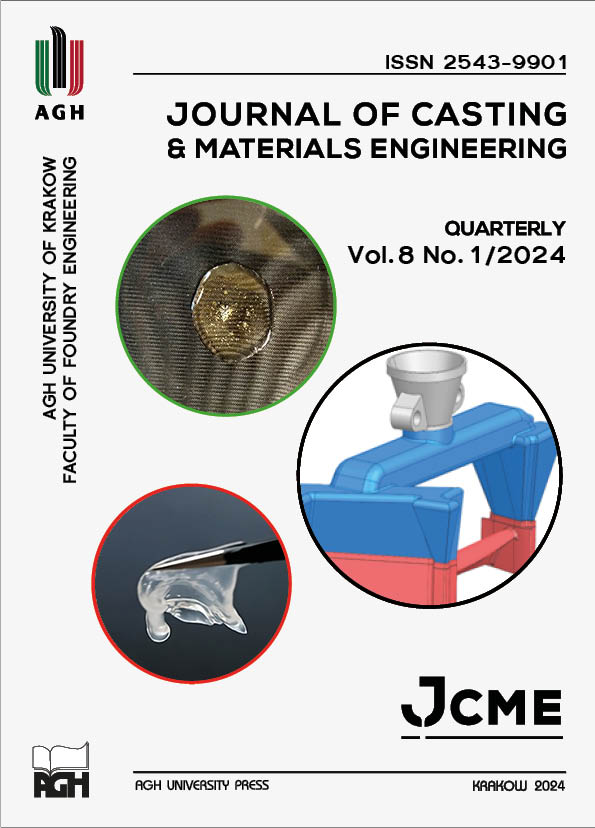Characterisation of Polacrylate-Polysacharide System. Part I. Infrared Structural Studies
DOI:
https://doi.org/10.7494/jcme.2024.8.1.11Keywords:
material engineering, hydrogel, native starch, polyacrylic acid, spectroscopy FT-IRAbstract
For the prepared polymer systems based on an poly(acrylic acid) and a colloidal solution of native starch, a series of IR (FTIR)
structural studies and tests under heating conditions (ATR-FTIR) were carried out. Two components from the group of native
starch of different biological origin (potato, cassava) were selected. The analysis of the collected results was aimed at assessing the effect of the biological origin of the starch on the structure, thermal sensitivity of the acrylic polymer-based system. On the basis of interaction effects occurring in the obtained synthetic polymer-natural polymer systems, the validity of mixing selected components to obtain composition was verified.
Downloads
References
Tyliszczak B. & Pielichowski K. (2007). Charakterystyka matryc hydrożelowych – zastosowania biomedyczne superabsorbentów polimerowych. Czasopismo Techniczne. Chemia, R. 104, 159–167.
Bogunia A. & Król J. (2018). Materiał hydrożelowy – nowa podstawa dla tkanek organizmu. https://www.innowacyjnystart.pl/ludzie/195-material-hydrozelowy-nowa-podstawa-dla-tkanek-organizmu [accessed: 12.08.2023].
Kazimierska-Drobny K. (2011). Symulacja procesów chemo-mechanicznych w porowatych żelach i identyfikacja parametrów modelu. Uniwersytet Kazimierza Wielkiego w Bydgoszczy [PhD thesis]. https://www.ippt.pan.pl/repository/doktoraty/open/2012kazimierska_doktorat.pdf [accessed: 12.08.2023].
Pluta J. & Karolewicz B. (2004). Hydrogels: Properties and application in the technology of drug form. I: The characteristic hydrogels. Polimery w Medycynie, 34(2), 3–19.
Qamruzzaman M., Ahmed F. & Mondal M.I.H. (2022). An overview on starch-based sustainable hydrogels: Potential applications and aspects. Journal of Polymers and the Environment, 30, 19–50. Doi: https://doi.org/10.1007/s10924-021-02180-9.
Material extrusion – FDM (n.d.). Retrieved from: https://make.3dexperience.3ds.com/processes/material-extrusion [accessed: 22.06.2022].
Li J., Wu C., Chu P.K. & Gelinsky M. (2020). 3D printing of hydrogels: Rational design strategies and emerging biomedical applications. Materials Science and Engineering R: Reports, 140, 100543. Doi: https://doi.org/10.1016/j.mser.2020.100543.
Li L., Zhang P., Zhang Z., Lin Q., Wu Y., Cheng A., Lin Y., Thompson C.M., Smaldone R.A. & Ke C. (2018). Hierarchical co-assembly enhanced direct ink Writing. Angewandte Chemie International Edition, 57(18), 5105–5109. Doi: https://doi.org/10.1002/anie.201800593.
Kijeński J., Migdał A., Rejewski P. & Kędziora A. (2016). Przemysłowa synteza kwasu akrylowego i akrylanów – droga do eliminacji białych plam w obszarze wytwórczym polskiego przemysłu chemicznego. Polimery, 61(10), 702–709. Doi: https://doi.org/10.14314/polimery.2016.702.
Szymańska J. & Bruchajzer E. (2012). Kwas akrylowy. Dokumentacja dopuszczalnych wielkości narażenia zawodowego. Podstawy i Metody Oceny Środowiska Pracy, 4(74), 69–97. https://yadda.icm.edu.pl/baztech/element/bwmeta1.element.baztech-a6f80ccf-5a8b-4711-b3f9-ae86f718d27d/c/Szymanska_kwas.pdf [accessed: 12.08.2023].
Grabowska B., Pilch-Pitera B., Kaczmarska K., Trzebicka B., Mendrek B., Drożyński D. & Łątka P. (2015). Właściwości kompozycji poli(kwas akrylowy)/modyfikowana skrobia stosowanej jako nowe spoiwo polimerowe. Polimery, 60(3), 179–185. Doi: https://doi.org/10.14314/polimery.2015.179.
Grabowska B., Holtzer M., Dańko R. Górny M., Bobrowski A. & Olejnik E. (2013). New BioCo binders containing biopolymers for foundry industry. Metalurgija, 52(1), 47–50. https://www.researchgate.net/publication/259558063.
Grabowska B. (2013). Nowe spoiwa polimerowe w postaci wodnych kompozycji z udziałem poli(kwasu akrylowego) lub jego soli i modyfikowanego biopolimeru. Kraków: Wydawnictwo Naukowe AKAPIT.
Dąbrowska A. & Jagiello B.U. (2009). Drogi rozkładu skrobi w roślinach. Kosmos. Problemy Nauk Biologicznych, 58(282–283), 211–220. http://kosmos.icm.edu.pl/PDF/2009/211.pdf.
Tomasik P. (2004). Chemical and Functional Properties of Food Saccharides. London: CRC Press LLC.
Wang S. & Copeland L. (2013). Molecular disassembly of starch granules during gelatinization and its effect on starch digestibility: a review. Food & Function, 4(11), 1564–1580. Doi: https://doi.org/10.1039/c3fo60258c.
Kaczmarska K. (2017). Sól sodowa karboksymetyloskrobi (CMS-Na) jako materiał do zastosowania w technologii mas formierskich. Kraków: Akademia Gorniczo-Hutnicza [PhD thesis].
Lewandowicz G. & Mączyński M. (1990). Chemiczna modyfikacja skrobi. Cz. I. Modyfikacja skrobi ziemniaczanej. Chemik, 1, 9–13.
Ma X., Wei R., Cheng J., Cai J. & Zhou J. (2011). Synthesis and characterization of pectin/poly (sodium acrylate) hydrogels. Carbohydrate Polymers, 86(1), 313–319. Doi: https://doi.org/10.1016/J.CARBPOL.2011.04.089.
Souda P. & Sreejith L. (2013). Poly (acrylate -acrylic acid-co-Maleic acid) hydrogel: A cost effective and efficient method for removal of metal ions from water. Separation Science and Technology, 48(18), 2795–2803. Doi: https://doi.org/10.1080/01496395.2013.809106.
Sadeghi M. & Soleimani F. (2012). Synthesis of pH-sensitive hydrogel based on starch-polyacrylate superabsorbent. Journal of Biomaterials and Nanobiotechnology, 3(2A), 310–314. Doi: https://doi.org/10.4236/jbnb.2012.322038.
Kizil R., Irudayaraj J. & Seetharaman K. (2002). Characterization of irradiated starches by using FT-Raman and FTIR spectroscopy. Journal of Agricultural and Food Chemistry, 50(14), 3912–3918. Doi: https://doi.org/10.1021/jf011652p.
Schuster K.C., Ehmoser H., Gapes J.R. & Lendl B. (2000). On-line FT-Raman spectroscopic monitoring of starch gelatinisation and enzyme catalysed starch hydrolysis. Vibrational Spectroscopy, 22(1–2), 181–190. Doi: https://doi.org/10.1016/S0924-2031(99)00080-6.
Sekkal M., Dincq V., Legrand P. & Huvenne J.P. (1995). Investigation of the glycosidic linkages in several oligosaccharides using FT-IR and FT Raman spectroscopies. Journal of Molecular Structure, 349, 349–352. Doi: https://doi.org/10.1016/0022-2860(95)08781-P.
Budarin V., Clark J.H., Hardy J.J.E., Luque R., Milkowski K., Tavener S.J. & Wilson A.J. (2006). Starbons: New starch-derived mesoporous carbonaceous materials with tunable properties. Angewandte Chemie – International Edition, 45(23), 3782–3786. Doi: https://doi.org/10.1002/anie.200600460.
Abdullah A.H.D., Chalimah S., Primadona I. & Hanantyo M.H.G. (2018). Physical and chemical properties of corn, cassava, and potato starchs. IOP Conference Series: Earth and Environmental Science, 160, 012003. Doi: https://doi.org/10.1088/1755-1315/160/1/012003.
Vasko P.D., Blackwell J. & Koenig J.L. (1971). Infrared and Raman spectroscopy of carbohydrates. Part I: Identification of O-H and C-H related vibrational modes for D-glucose, maltose, cellobiose, and dextran by deuterium-substitution methods. Carbohydrate Research, 19, 297–310.
Vasko P.D., Blackwell J. & Koenig J.L. (1972). Infrared and Raman spectroscopy of carbohydrates. Part II: Normal and coordinate analysis of α-D-glucose. Carbohydrate Polymers, 23, 407–416. Doi: https://doi.org/10.1016/S0008-6215(00)82690-7.
Zaltariov M.F., Filip D., Varganici C.D. & Macocinschi D. (2018). ATR-FTIR and thermal behavior studies of new hydrogel formulations based on hydroxypropyl methylcellulose/poly(acrilic acid) polymeric blends. Cellulose Chemistry and Technology, 52(7–8), 619–631. https://www.cellulosechemtechnol.ro/pdf/CCT7-8(2018)/p.619-631.pdf [accessed: 12.08.2023].
Downloads
Published
Issue
Section
License
Copyright (c) 2024 Karolina Kaczmarska, Mateusz Śmietana, Dariusz Drożyński, Faustyna Woźniak, Artur Bobrowski

This work is licensed under a Creative Commons Attribution 4.0 International License.
How to Cite
Accepted 2023-09-21
Published 2024-03-30


